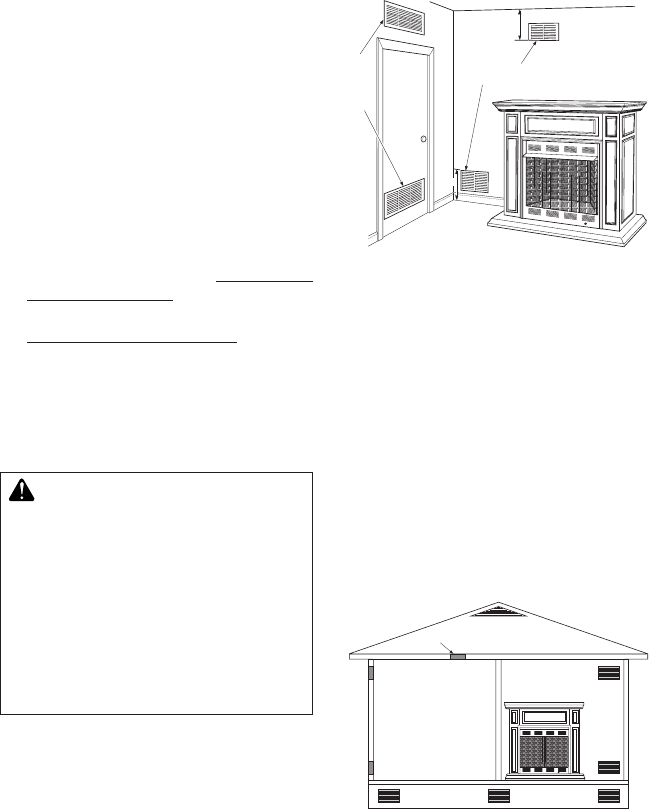
www.desatech.com
119505-01E6
AIR FOR COMBUSTION AND VENTILATION
Continued
Ventilation Air From Outdoors
Provide extra fresh air by using ventilation
grills or ducts. You must provide two perma-
nent openings: one within 12" of the ceiling
and one within 12" of the oor. Connect these
items directly to the outdoors or spaces open
to the outdoors. These spaces include attics
and crawl spaces. Follow the National Fuel
Gas Code ANSI Z223.1/NFPA 54, Air for
Combustion and Ventilation for required size
of ventilation grills or ducts.
IMPORTANT: Do not provide openings for
inlet or outlet air into attic if attic has a thermo-
stat-controlled power vent. Heated air entering
the attic will activate the power vent.
Figure 4 - Ventilation Air from Inside
Building
Or
Remove
Door into
Adjoining
Room,
Option
3
Ventilation Grills
Into Adjoining Room,
Option 2
Ventilation
Grills Into
Adjoining
Room,
Option 1
12"
12"
Figure 5 - Ventilation Air from Outdoors
Outlet
Air
V entilated
Attic
Outlet
Air
Inlet
Air
Inlet Air
V entilated
Crawl Space
T o
Crawl
Space
T o Attic
Example:
Gas water heater ___________Btu/Hr
Vent-free replace + __________Btu/Hr
Total = __________Btu/Hr
4.
Compare the maximum Btu/Hr the space can
support with the actual amount of Btu/Hr used.
_______ Btu/Hr (maximum the space can
support)
_______ Btu/Hr (actual amount used)
Example: 51,200 Btu/Hr (maximum the
space can support)
79,000 Btu/Hr (actual amount of
Btu/Hr used)
The space in the above example is a conned
space because the actual Btu/Hr used is more
than the maximum Btu/Hr the space can sup-
port. You must provide additional fresh air. Your
options are as follows:
A. Rework worksheet, adding the space
of an adjoining room. If the extra space
provides an unconned space, remove
door to adjoining room or add ventilation
grills between rooms. See Ventilation Air
From Inside Building.
B. Vent room directly to the outdoors. See
Ventilation Air From Outdoors.
C. Install a lower Btu/Hr heater, if lower Btu/
Hr size makes room unconned.
If the actual Btu/Hr used is less than the
maximum Btu/Hr the space can support, the
space is an unconned space. You will need
no additional fresh air ventilation.
WARNING: If the area in which
-
National Fuel
Gas Code, ANSI Z223.1/NFPA 54,
the International Fuel Gas Code,
VENTILATION AIR
This fresh air would come from an adjoining
unconned space. When ventilating to an
adjoining unconned space, you must provide
two permanent openings: one within 12" of the
ceiling and one within 12" of the oor on the
wall connecting the two spaces (see options
1 and 2, Figure 4). You can also remove door
into adjoining room (see option 3, Figure 4).
Follow the National Fuel Gas Code ANSI
Z223.1/NFPA 54, Air for Combustion and
Ventilation for required size of ventilation
grills or ducts.
40,000
39,000
79,000


















